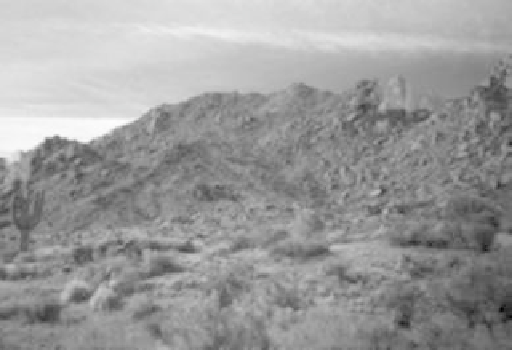Environmental Engineering Reference
In-Depth Information
An additional force in movement of sediments is the wind. Dust storms can transport
millions of tons of fine sediment over thousands of kilometers; Saharan dust can cross
the Atlantic Ocean to deposit in North America. Wind can abrade, transport, and deposit
small sedimentary particles through the process of saltation, and this process is thought
to be the most important reason for erosion. In this process, particles are transported by
the wind in short parabolic arcs that result in impacts with other particles on the ground.
These impacts provide enough energy to dislodge other particles on the soil surface and
make them available for transport by the wind. Saltation of particles can continue as long
as the wind is blowing and there are sediments available for transport. Constant winds
bearing small particles can also sculpt individual rocks, essentially sandblasting them into
fluted and polished forms called
ventifacts
. Small oriented grooves in ventifacts left by the
wind-borne particles can often be used to map past wind patterns in desert environments.
Sedimentary particles transported and deposited by eolian processes are also thought to
be a major source of material for new soil development in deserts by providing a constant
source of new sediments to the soil surface.
10
2.7 Desert Landforms
As with desert geological processes, landforms found in deserts are a subject of much
previous and continuing study. The major landforms found in desert piedmonts are
presented here; these have been further classified into many distinct subtypes, which are
not discussed here.* The mountain front region, or
piedmont
, is defined as the interface
between the hillslope and fluvial (river) environments (Figure 2.5). Landforms in the
piedmont reflect the balance between the availability of source material from hillslopes
versus the capacity of eolian and fluvial processes to transport the material away. If more
FIGURE 2.5
This piedmont region along the northeast side of the McDowell Mountains, Scottsdale, Arizona, is the interface
between hillslope and fluvial (river channel) transport processes. (Courtesy of W.L. Stefanov.)
*
For a more thorough presentation, see Cooke et al.
2


Search WWH ::

Custom Search